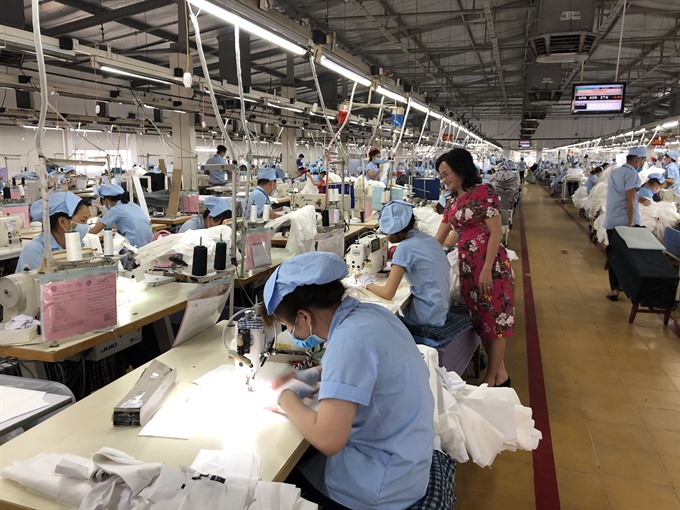 Society
Society

Earning enough money to cover daily essentials is a real problem for most garment workers.
 |
| Garment workers at a factory in Bình Dương Province. Photo for illustration only. — VNA/VNS Photo Nguyễn Văn Việt |
By Khoa Thư
HÀ NỘI – Eight hours a day, five days a week, 35-year-old Nguyễn Thị Hoa (*) painstakingly looks for tiny defects in thousands of apparel products at a dusty garment factory in Lai Vu Industrial Zone, the northern province of Hải Dương.
She earns VNĐ4.9 million (US$210) a month.
There is no better alternative for Hoa the moment. She left her job at an electronics assembly factory to work here for a better schedule, but her salary was the same.
“It is impossible to live a proper life with that amount of money,” said Hoa.
Leaving her husband behind in the central province of Thanh Hóa, she moved to the emerging industrial hub in Hải Dương with a clear goal, “earning enough money to start a business.”
This target now seems out of reach, as she can hardly cover her living expenses.
Nearly three million garment workers in Việt Nam, mostly women, are in similar situations.
A study of fashion suppliers in Việt Nam conducted by the Institute of Workers and Unions and Oxfam Việt Nam found that 99 per cent of surveyed workers earn below the Asia Floor Wage of VNĐ8.9 million ($382) while 74 per cent earn below the Global Living Wage Coalition (Anker) benchmark of VNĐ5.2 million ($223).
The national average minimum wage in Việt Nam of VNĐ3.34 million ($143) is not enough for a person to live at the most basic level.
Even though the wages of most garment workers are higher than minimum wage, they “fall short of what is considered a living wage,” the research found.
A living wage should cover eight essentials including nutritious food, decent housing, healthcare, utilities, education, clothing, transportation and savings.
Hoa doesn’t have a living wage, so she can’t save the money she wants to send home.
To try and achieve her dream of starting her own business, she works overtime.
“Almost all workers spend extra hours at the factory. The pay is 1.5 times higher for each hour,” she said.
Aiming to earn more money, Hoa stays late, from one hour up to three hours in busy seasons.
She does not dare take a break or show up late as her monthly bonus for attendance of VNĐ300,000 ($12.9) will be cut.
“When I have a minor illness, it is better to go to a local medical facility for a check-up and buy medicine,” she said.
“Although we pay for insurance, it takes time to ask for leave and go to hospital. If I’m absent one day my income will be cut short. I simply do not want that to happen,” Hoa added.
65 per cent of surveyed workers said they regularly take overtime while 22 per cent said they did not use annual leave and even go to the toilet quickly.
Getting to work late, taking sick leave, violating the rules or failing to meet production quotas can result in wage deductions.
And when workers take annual leave, they will receive half or sometimes none of their attendance allowance.
Long and arduous road
“Many workers told me that they had to work overtime to earn enough for living,” said Vũ Quang Thọ, former head of the Union Institute and a former member of the National Salary Council.
However, the impacts of overtime on workers’ health are severe and 53 per cent of them cannot afford medical treatment and medicine, meaning they are sacrificing their health for employment.
“Therefore, it is essential to raise the minimum wage besides other assistance policies,” said Thọ.
By increasing the wages of workers by 1 per cent, employers can ease heavy financial burdens they are bearing, the research recommends.
In reality, that isn’t as easy as it sounds.
According to Tống Thị Minh, former head of the Department of Labour Relations, Việt Nam’s textile industry focuses mostly on manufacturing.
Increasing 1 per cent of employees’ wages means costs would rise 3 or 4 per cent.
As manufacturing costs account for 92 per cent of the industry’s revenue, profit will be reduced by wage lifts.
Garment factories are facing deadlock. While costs increase, buyer’s purchasing prices fall.
Since their negotiation power cannot fight the fierce competition with other suppliers, manufacturing enterprises impose sanctions on workers to keep prices low.
“Committing to preventing the race to bottom should be prioritised,” Minh said.
“The membership of new-generation FTAs and the Comprehensive and Progressive Agreement for Trans-Pacific Partnership (CPTPP) includes codes of conducts that offer Vietnamese garment companies better opportunities in price negation. They are also asked to share social responsibilities and allow workers to ask for wage rises,” she added.
The road, however, is arduous and long.
“It will take at least five to 10 years for garment workers to enjoy the living wage they deserve,” said Vũ Minh Tiến, head of the Union Institute.
“At least we are making the first steps,” he added.
But Hoa cannot wait.
She is 35 now while the average age of garment workers is 30.4 and the turnover rate is about 40 per cent a year.
“I know it all, that my wage is too low, that the working conditions are bad, that my body is being destroyed. I know but cannot do anything,” she said in vain. – VNS
(*) Not her real name.




